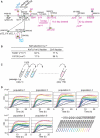Evolutionary genome engineering using a restriction-modification system
- PMID: 21785135
- PMCID: PMC3203608
- DOI: 10.1093/nar/gkr585
Evolutionary genome engineering using a restriction-modification system
Abstract
Modification of complex microbial cellular processes is often necessary to obtain organisms with particularly favorable characteristics, but such experiments can take many generations to achieve. In the present article, we accelerated the experimental evolution of Escherichia coli populations under selection for improved growth using one of the restriction-modification systems, which have shaped bacterial genomes. This resulted in faster evolutionary changes in both the genome and bacterial growth. Transcriptome/genome analysis at various stages enabled prompt identification of sequential genome rearrangements and dynamic gene-expression changes associated with growth improvement. The changes were related to cell-to-cell communication, the cell death program, as well as mass production and energy consumption. These observed changes imply that improvements in microorganism population growth can be achieved by inactivating the cellular mechanisms regulating fraction of active cells in a population. Some of the mutations were shown to have additive effects on growth. These results open the way for the application of evolutionary genome engineering to generate organisms with desirable properties.
Figures








Similar articles
-
A DNA methyltransferase can protect the genome from postdisturbance attack by a restriction-modification gene complex.J Bacteriol. 2002 Nov;184(22):6100-8. doi: 10.1128/JB.184.22.6100-6108.2002. J Bacteriol. 2002. PMID: 12399478 Free PMC article.
-
A Novel Tool for Microbial Genome Editing Using the Restriction-Modification System.ACS Synth Biol. 2018 Jan 19;7(1):98-106. doi: 10.1021/acssynbio.7b00254. Epub 2017 Oct 12. ACS Synth Biol. 2018. PMID: 28968490
-
Conflicts targeting epigenetic systems and their resolution by cell death: novel concepts for methyl-specific and other restriction systems.DNA Res. 2010 Dec;17(6):325-42. doi: 10.1093/dnares/dsq027. Epub 2010 Nov 8. DNA Res. 2010. PMID: 21059708 Free PMC article. Review.
-
Behavior of restriction-modification systems as selfish mobile elements and their impact on genome evolution.Nucleic Acids Res. 2001 Sep 15;29(18):3742-56. doi: 10.1093/nar/29.18.3742. Nucleic Acids Res. 2001. PMID: 11557807 Free PMC article. Review.
-
Bacterial Evolution in High-Osmolarity Environments.mBio. 2020 Aug 4;11(4):e01191-20. doi: 10.1128/mBio.01191-20. mBio. 2020. PMID: 32753494 Free PMC article.
Cited by
-
Semi-supervised prediction of gene regulatory networks using machine learning algorithms.J Biosci. 2015 Oct;40(4):731-40. doi: 10.1007/s12038-015-9558-9. J Biosci. 2015. PMID: 26564975
-
To be or not to be: regulation of restriction-modification systems and other toxin-antitoxin systems.Nucleic Acids Res. 2014 Jan;42(1):70-86. doi: 10.1093/nar/gkt711. Epub 2013 Aug 13. Nucleic Acids Res. 2014. PMID: 23945938 Free PMC article. Review.
-
Conservation of Dcm-mediated cytosine DNA methylation in Escherichia coli.FEMS Microbiol Lett. 2012 Mar;328(1):78-85. doi: 10.1111/j.1574-6968.2011.02482.x. Epub 2012 Jan 6. FEMS Microbiol Lett. 2012. PMID: 22150247 Free PMC article.
-
MamA essentiality in Mycobacterium smegmatis is explained by the presence of an apparent cognate restriction endonuclease.BMC Res Notes. 2020 Sep 29;13(1):462. doi: 10.1186/s13104-020-05302-z. BMC Res Notes. 2020. PMID: 32993774 Free PMC article.
-
Genomic Features and Pervasive Negative Selection in Rhodanobacter Strains Isolated from Nitrate and Heavy Metal Contaminated Aquifer.Microbiol Spectr. 2022 Feb 23;10(1):e0259121. doi: 10.1128/spectrum.02591-21. Epub 2022 Feb 2. Microbiol Spectr. 2022. PMID: 35107332 Free PMC article.
References
-
- Ideker T, Galitski T, Hood L. A new approach to decoding life: systems biology. Annu. Rev. Genomics. Hum. Genet. 2001;2:343–372. - PubMed
-
- Posfai G, Plunkett G, III, Feher T, Frisch D, Keil GM, Umenhoffer K, Kolisnychenko V, Stahl B, Sharma SS, de Arruda M, et al. Emergent properties of reduced-genome Escherichia coli. Science. 2006;312:1044–1046. - PubMed
-
- Hashimoto M, Ichimura T, Mizoguchi H, Tanaka K, Fujimitsu K, Keyamura K, Ote T, Yamakawa T, Yamazaki Y, Mori H, et al. Cell size and nucleoid organization of engineered Escherichia coli cells with a reduced genome. Mol. Microbiol. 2005;55:137–149. - PubMed

